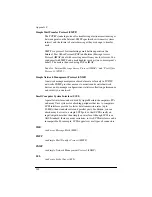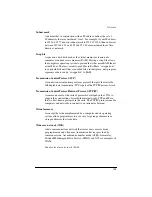
197
Internet domain
An Internet domain is a host naming convention used to ensure that no
two individual hosts on the global Internet have the same host name. An
Internet domain should not be confused with an NT Domain.
Internet Message Access Protocol (IMAP)
Internet Message Access Protocol is a standard protocol for accessing
email from your local server. IMAP is a client/server protocol in which
email is received and held for you by your Internet server. You (or your
email client) can view just the heading and the sender of the letter and
then decide whether to download the mail from the server. You can also
create and manipulate folders or mailboxes on the server, delete
messages or search for certain parts or an entire note. IMAP requires
continuous access to the server during the time that you are working
with your mail.
IMAP can be thought of as a remote file server. Another protocol, Post
Office Protocol (POP), can be thought of as a store-and-forward service.
POP and IMAP deal with receiving email from your local server;
Simple Mail Transfer Protocol (SMTP) is a protocol for transferring
email between points on the Internet. You send email with SMTP and a
mail handler receives it on your recipient’s behalf. Then the mail is read
using POP or IMAP.
See also
“Post Office Protocol 3 (POP3)”
.
Internet Protocol (IP)
A network-layer protocol in the TCP/IP stack offering a connectionless
internetwork service. IP provides features for addressing,
type-of-service specification, fragmentation and reassembly, and
security. IP is defined in RFC 791.
Summary of Contents for Cobalt Qube 2
Page 1: ...Cobalt QubeTM 2 User Manual...
Page 6: ...vi...
Page 20: ...Chapter 1 6 Figure 3 Administrator Site screen Figure 4 Public Site screen...
Page 26: ...Chapter 1 12...
Page 68: ...Chapter 3 54...
Page 70: ...Chapter 4 56 Figure 17 Administrator Site screen...
Page 76: ...Chapter 4 62 Figure 19 shows the User Defaults table Figure 19 User Defaults table...
Page 78: ...Chapter 4 64 Figure 20 shows the Add New User table Figure 20 Add New User table...
Page 87: ...Administrator Site 73 Figure 24 shows the Add New Group table Figure 24 Add New Group table...
Page 184: ...Appendix B 170...
Page 206: ...Appendix E 192...
Page 218: ...Appendix F 204...






















